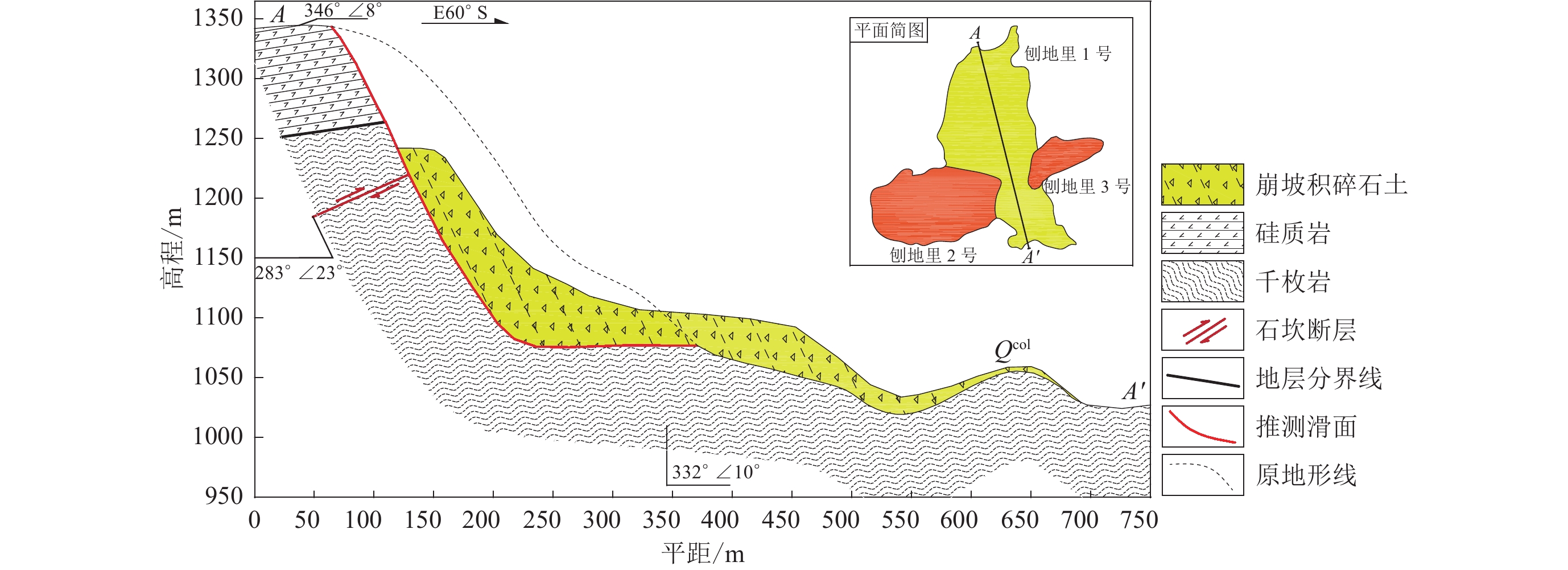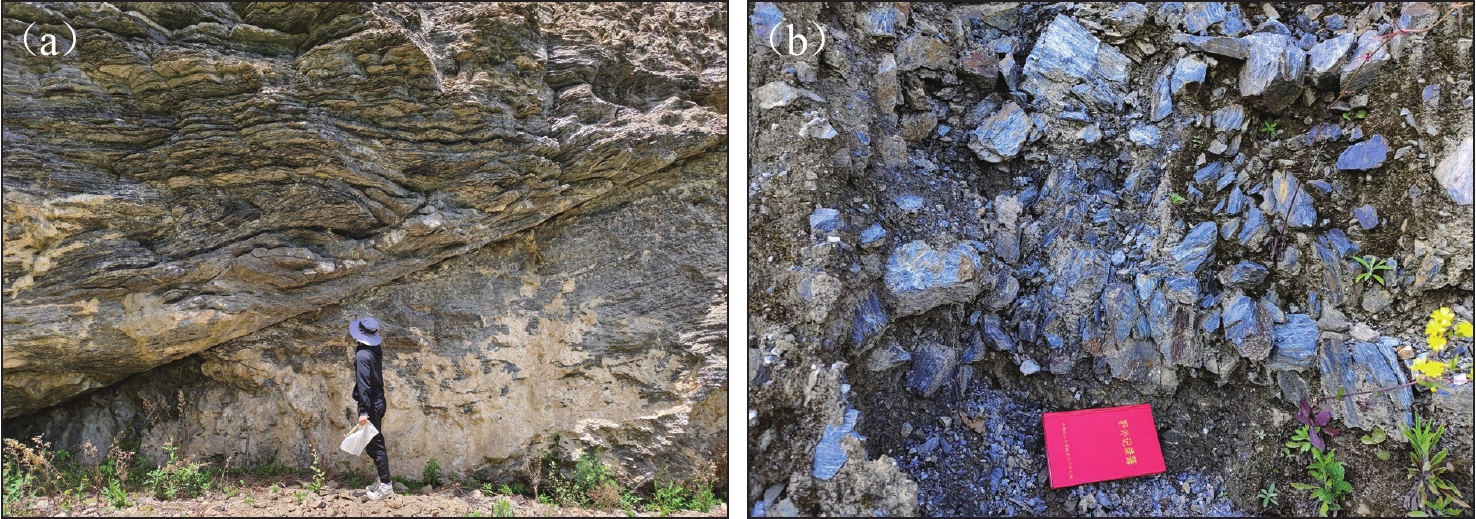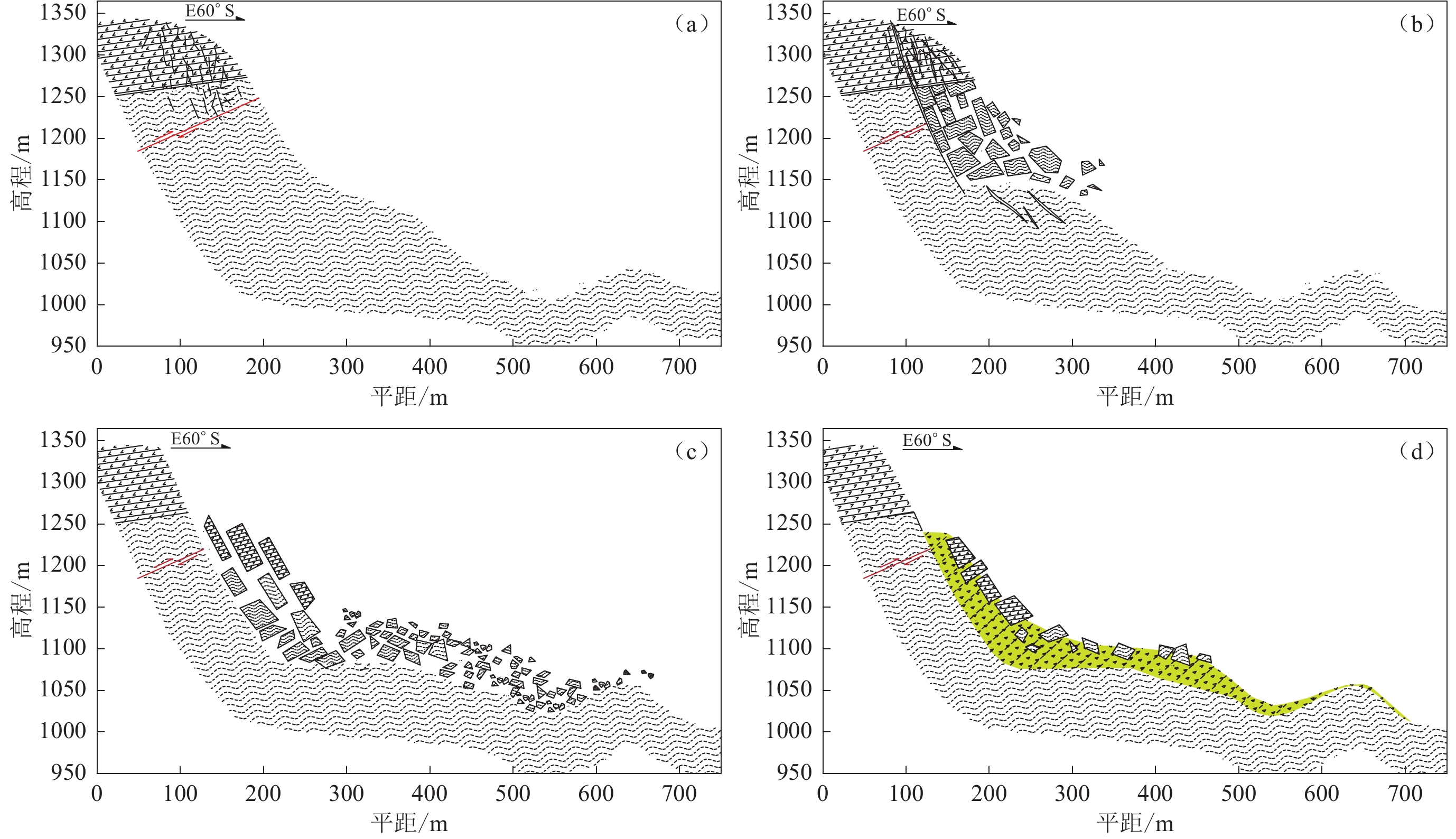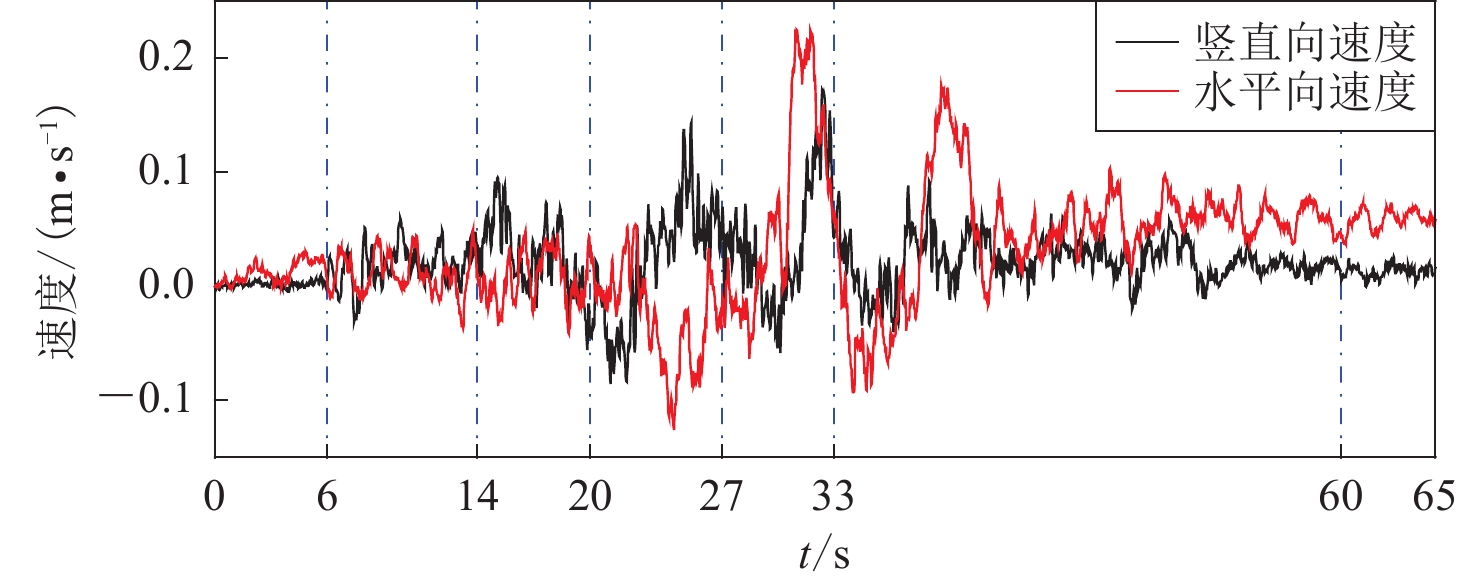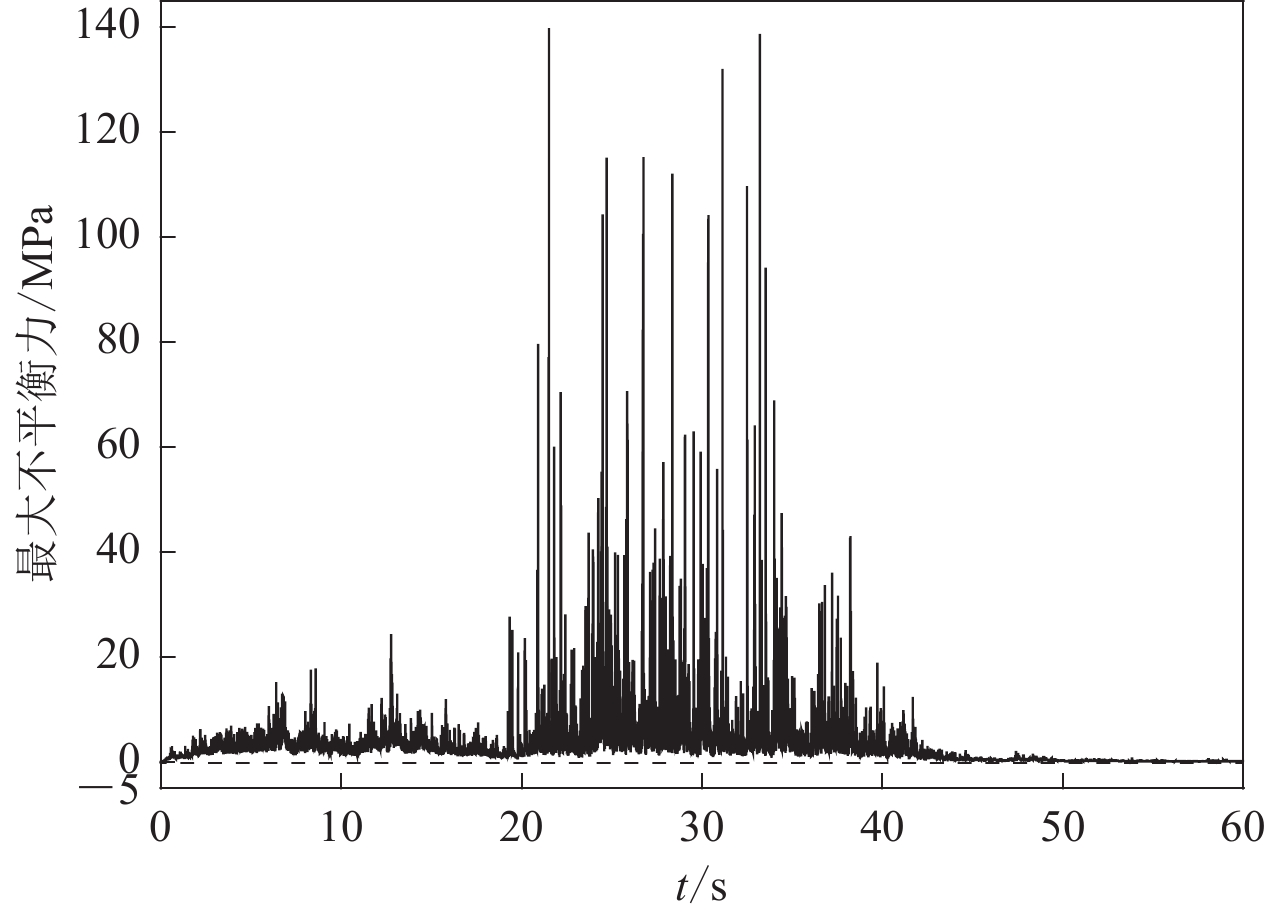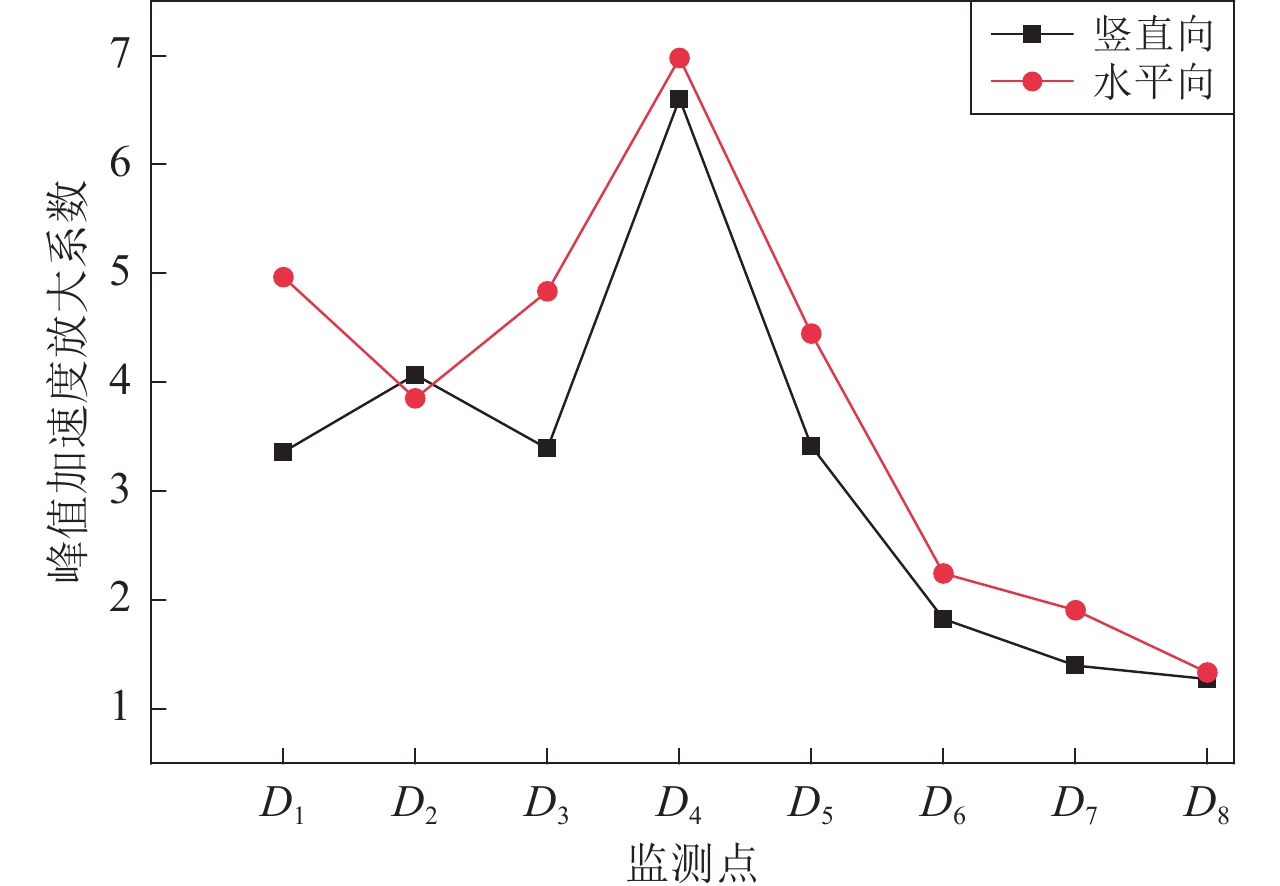Analysis of characteristics and failure mechanism of Paodili seismic landslide in Qingchuan County
-
摘要:
以“5·12”汶川地震诱发的青川县刨地里滑坡为例,现场调查了滑坡的地质特征,并基于离散元软件(UDEC)分析了1号滑坡动力响应及变形破坏过程,探讨了滑坡的成因机制。现场调查表明,刨地里1号滑坡具有近水平“上硬下软”的地层结构,其中石坎断层穿过了滑坡后缘;滑坡堆积体的岩性分带特征表明,刨地里1号滑坡下部千枚岩先于上部硅质岩被破坏,且破坏时间早于2号和3号滑坡;数值模拟研究揭示,峰值加速度放大效应在断层带附近的千枚岩内最强,其放大系数达6.79,导致下层千枚岩首先沿陡倾面产生拉裂破坏,随后上层硅质岩体产生拉裂破坏,结果与现场调查堆积物特征较吻合;断层和上硬下软的地层结构对刨地里滑坡动力响应、变形及破坏起到了控制作用。该研究可为上硬下软且含断层的地震滑坡的评价提供参考。
-
关键词:
- “5·12”汶川地震 /
- 地震滑坡 /
- 上硬下软地层 /
- 石坎断层 /
- 成因机制
Abstract:The problem of slope stability in high-intensity mountainous area is prominent. It is of great significance to study the relationship between geological structure and strata structure and the triggering mechanism of landslide under earthquake action. In this paper, the geological characteristics of the landslide in Qingchuan County are investigated, and the dynamic response and deformation and failure process of the 1st landslide are analyzed based on discrete element software (UDEC). The field investigation shows that the slope of Paodili 1st landslide has a near-horizontal “upper-hard, lower-soft” stratigraphic texture, in which faults pass through the back edge of the slope. The lithologic zonation of landslide deposits shows that the lower phyllite of Paodili 1st landslide was destroyed earlier than the upper siliceous rock, and the broken time was earlier than the 2nd and 3rd landslides. The numerical simulation research reveals that the peak acceleration amplification effect is strongest in phyllite near the fault zone, with an amplification factor of 6.79. This leads to the lower phyllite first experienced tensile failure along the steep dip surface, then the upper siliceous rock mass produced tension failure. The results are in good agreement with the characteristics of the deposits in the field investigation. The dynamic response, deformation, and failure of the landslide are controlled by the fault and the upper-hard, lower soft stratigraphic texture. This study can provide a reference for seismic landslides evaluation in regions characterized by faulting and “upper-hard, lower-soft” strata.
-
引 言
高烈度山区斜坡稳定性问题突出,在地震作用下,研究地质构造和地层结构与滑坡触发机制的关系具有重要意义。我国西部地区地震滑坡等地质灾害极为发育,“5·12”汶川特大地震触发了超过19万7 000处滑坡、崩塌等地质灾害(许冲等,2013),造成近三万余人遇难,约占总遇难人数的1/3 (黄润秋,2011)。汶川地震之后,大量学者对强震诱发滑坡的成因及其形成机制开展了研究:通过遥感解译和现场调查发现大型滑坡与发震断层瞬间的错动密切相关(黄润秋等,2009;许强,李为乐,2010),而断层上盘效应是触发高速远程滑坡的主要原因(汤明高等,2011);李强等(2019)对2017年九寨沟MS7.0地震中的地震滑坡分布特征开展分析,揭示了滑坡分布存在明显的断层效应;2022年泸定MS6.8地震中,地震滑坡分布与距断层的距离密切相关,滑坡主要分布在断层1 km范围内,若距离超过1 km则滑坡分布密度显著降低(范宣梅等,2022)。可见,断层与地震的滑坡成因具有密切联系。
典型地震滑坡研究表明,地震易诱发滑坡后缘形成陡倾的拉张破坏(Wang et al,2019)。青川东河口高速远程滑坡启动区的断层破碎带以及力学性质较差的千枚岩、板岩的存在,均对该滑坡的启动有着显著影响(孙萍等,2009)。刘家湾滑坡不同岩性组合斜坡具有明显的差异特性,软硬岩层交界面的动力突变效应耦合凸出地形是导致斜坡破坏的主要原因(何源等,2015;Luo et al,2021)。大量振动台试验揭示,在水平向地震波作用下上硬下软组合斜坡比上软下硬组合斜坡对加速度的放大程度更大(许强等,2010)。有限元分析表明,软弱夹层使坡体出现了局部放大效应,动力响应具有软岩大于硬岩、层状大于均质的特点(宋丹青等,2021)。地震作用下对某软硬互层斜坡的研究表明,软岩是坡体变形破坏的优势拉裂区域,在强震的应力挤压作用下,坡体内强风化千枚岩因其质软而变形强烈,有向外剪出的趋势(刘云鹏等,2012)。岩质斜坡稳定性受地层层面和节理面密度的控制,滑动面常为后缘节理面和软弱夹层的贯通面,地震时易沿软弱夹层和后缘节理贯通面发生破坏,如孙家滑坡、大竹坪滑坡等(刘新荣等,2019;谭明健等,2022)。以上研究表明,不同物理力学性质的岩性组合是诱发地震滑坡的重要因素。
受“5·12”汶川强震作用,青川县石坝乡刨地里形成了多处同震滑坡。本文拟以刨地里滑坡为研究对象,通过调查该滑坡发育特征构建地质模型,并结合数值模拟对其放大效应特征和变形破坏过程开展深入研究,对滑坡成因机制开展探讨,以期为同类地震滑坡分析提供有价值的参考。
1. 研究区地质概况
研究区位于四川省青川县石坝乡(图1),处于龙门山系北段,区域山脉走向与地质构造走向基本一致,大多呈NE—SW向,所在地层为寒武系下统邱家河组(Єq),岩性为深灰色千枚岩夹硅质岩。研究区内的石坎断层走向NE—SW,断层面产状为283°∠23°,可见断层泥,夹有少量假玄武玻璃和断层角砾岩,新鲜断层泥呈灰白色,稍湿,风化后呈深灰色,主要成分为方解石和黏土矿物。断层两侧岩性为薄层状千枚岩,并发育大量褶皱,总体上产状较平缓,局部可见钙华和碎裂岩体崩塌。
![]() 图 1 刨地里滑坡地理位置图(修改自黄润秋等,2009)Figure 1. Geographical location map of Paodili landslide (modified from Huang et al,2009)
图 1 刨地里滑坡地理位置图(修改自黄润秋等,2009)Figure 1. Geographical location map of Paodili landslide (modified from Huang et al,2009)2. 滑坡基本特征
刨地里地震滑坡共3处(图2),发育特征如下:1号滑坡位于图幅北侧,后缘高程约1 326 m,坡脚高程约1 050 m,高差约276 m,滑坡长约为750 m,宽约为350 m,平均厚度约为25 m,堆积方量约为1.84×106 m3,地震发生时滑坡向南侧滑动,滑体运动距离约为250 m。滑坡后部高陡,坡度为35°—45°,中部坡度约为30°,前部堆积体较厚而坡度平缓,为10°—20°,滑坡地形具有上陡下缓的特征。2号滑坡位于南侧,后缘高程约1 280 m,坡脚高程约1 075 m,高差约205 m,坡角约34°,滑坡长约为450 m,宽约为200 m,平均厚度约为12 m,堆积方量约为2.4×105 m3,地震发生时滑坡向北东侧滑动。3号滑坡位于东侧,平面形态呈舌型,后缘高程约为1 210 m,坡脚高程约为1 090 m,滑坡长约为230 m,宽约为100 m,平均厚度为6 m,堆积方量约3.5×104 m3,地震发生时滑坡向南西侧滑动。
根据滑坡的发育、运动及堆积特征,将1号滑坡分为滑源区和堆积区(图2),其中堆积区又可分为硅质岩堆积区和千枚岩堆积区两个亚区。各区特征如下:
1) 滑源区。出露高程1 200—1 350 m,滑源区长约200 m,宽约200 m,地形坡度为40°—45°。顶部岩性出露为厚层状硅质岩(图3a,b),质地坚硬。岩层产状332°∠5°,两组节理面产状分别为68°∠81°和150°∠53°。下部岩性出露为土黄色薄层状千枚岩(图3c),节理裂隙发育,岩体力学性质较差,产状为338°∠8°。大量硅质岩巨石在此区堆积(图3d),块径多为5 m×4 m×3 m,平整面多为节理面,表面擦痕清晰,破裂的岩块、碎块尚可拼合。石坎断层贯穿滑源区,带内可见断层角砾岩,呈碎裂状。结合现场调查和已有资料,未发现研究区内在汶川地震期间存在地表破裂。
![]() 图 3 刨地里滑坡发育分布与堆积特征(a) 硅质岩;(b) 擦痕;(c) 千枚岩;(d) 滑源区巨块石;(e) 硅质岩堆积区;(f) 假基岩体Figure 3. Distribution and accumulation characteristics of Paodili landslide(a) Siliceous rock;(b) Scratches;(c) Phyllite;(d) Large block stones in the sliding source area; (e) Siliceous rock accumulation area;(f) Pseudobasic rock mass
图 3 刨地里滑坡发育分布与堆积特征(a) 硅质岩;(b) 擦痕;(c) 千枚岩;(d) 滑源区巨块石;(e) 硅质岩堆积区;(f) 假基岩体Figure 3. Distribution and accumulation characteristics of Paodili landslide(a) Siliceous rock;(b) Scratches;(c) Phyllite;(d) Large block stones in the sliding source area; (e) Siliceous rock accumulation area;(f) Pseudobasic rock mass2) 硅质岩堆积区。位于堆积区后侧,区域内由大量裂解的硅质岩块组成(图3e),块径多为1 m×0.6 m×0.5 m,明显小于滑源区的硅质岩大块石。
3) 千枚岩堆积区。位于堆积体前侧,物质组成主要为千枚岩块石,粒径范围1—25 cm,自滑源区方向碎块石粒径由大变小。可见数座小型假基岩,部分产状50°∠21°,25°∠38°,150°∠50°,与滑床产状差异较大。新鲜面形态不规整,推测为原斜坡的裂隙,其中典型的一座长宽高各约为15 m×10 m×8 m,与底部的板岩堆积体分界清晰(图3f)。
2号滑坡滑源区可见多级台坎分布,出露岩性为中风化千枚岩,产状313°∠40°。表层为第四系黄色黏土夹碎石,碎石呈次棱角状,粒径2—15 cm,下部为千枚岩,节理裂隙发育。2号滑坡堆积区为土黄色黏土夹碎石土。3号滑坡仅可见少量碎石和黏土。2号和3号滑坡与1号滑坡间可见清晰肉红色土体堆积边界,且均覆盖在1号滑坡堆积体之上(图2)。
针对各滑坡体的接触关系及边界行迹的调查表明,1号滑坡先于2号及3号滑坡失稳。下文对地震滑坡的影响因素及失稳过程均以1号滑坡为主进行论述。
3. 影响因素分析
3.1 上硬下软的岩体结构
刨地里1号滑坡为典型的近水平上硬下软结构(图4),其上部为硅质岩,相对坚硬,下部为薄层千枚岩,岩性较软且褶皱发育。受构造作用等影响,斜坡具有复杂的应力史,坡体内褶皱和节理裂隙发育,受风化作用影响岩体物理力学强度进一步弱化。根据振动台物理模拟、数值分析等研究(许强等,2010;宋丹青等,2021),上硬下软岩体组合斜坡在强震作用下斜坡动力响应强烈,对斜坡稳定性极为不利。
3.2 断层影响
研究区内石坎断层为顺扭走滑—逆冲型断层,在南坝地区存在一定的地表破裂(李传友,魏占玉,2009;张伟,2009),但无相关资料及现场证据表明该断层在刨地里附近存在地表破裂。斜坡内断层经过多次活动,断层角砾岩岩体破碎,沿断层带形成地下导水通道,进一步弱化岩体质量,在强震作用下不利于斜坡稳定性(图5a,b)。
4. 滑坡失稳过程
由第2节可知,1号滑坡堆积体后侧主要为硅质岩块石,前侧主要为强风化千枚岩及黏土,表明斜坡下部千枚岩首先开始破坏,导致了顶部硅质岩失稳崩塌。失稳过程具体如下:
1) 斜坡地震动强烈放大
上硬下软的地层结构使得下部千枚岩岩体在长期的地质内外动力作用下发育裂隙,形成了斜坡易滑块体(图6a)。一方面,地震发生时岩性分界处产生极大的拉应力和剪应力,导致易滑块体下滑力增大而抗滑力减小(Luo et al,2021)。另一方面,强震动作用使得拉张裂隙向深部延伸,随之在地震动的循环荷载作用下形成贯通结构面,块体失稳下滑(图6b)。
![]() 图 6 刨地里1号滑坡破坏过程演示图(a) 斜坡震动强放大;(b) 下部岩体震裂破坏;(c) 上部岩体失稳滑动;(d) 运动堆积阶段Figure 6. Destruction process demonstration diagram of Paodili 1st landslide(a) Amplification effect of strong vibration on slope;(b) Seismic fracture failure of the lower rock structure;(c) Sliding after instability of the upper rock structure;(d) Motion and accumulation
图 6 刨地里1号滑坡破坏过程演示图(a) 斜坡震动强放大;(b) 下部岩体震裂破坏;(c) 上部岩体失稳滑动;(d) 运动堆积阶段Figure 6. Destruction process demonstration diagram of Paodili 1st landslide(a) Amplification effect of strong vibration on slope;(b) Seismic fracture failure of the lower rock structure;(c) Sliding after instability of the upper rock structure;(d) Motion and accumulation2) 下部岩体震裂破坏—上部岩体失稳滑动
在地震动作用下,软弱千枚岩体震裂破坏,以较高的初速度启动,并沿170°方向运移。顶部的硅质岩在底部失稳后,沿优势破裂面破坏后向下滑动(图6c)。
3) 运动堆积阶段
前侧滑坡体主要由千枚岩组成,部分未解体的大型千枚岩体成为假基岩体堆积于前侧。后侧滑坡体主要由硅质岩组成。1号滑坡体到达沟谷后遇阻(2号和3号滑坡体),受挤压变形后在原地堆积形成滑坡坝,上游形成堰塞湖(图6d)。
5. 数值模拟分析
5.1 离散元模型建立
基于以上定性分析,本节利用1号滑坡工程地质剖面原型建立离散元(universal distinct element code)二维模型(图7)。模型建立方法如下:① 由于刨地里斜坡岩体风化程度具有明显分带性,且地震对斜坡内部的稳定性影响较小(李龙起等,2020),模型按岩体风化程度分为上层风化岩体和下层微新岩体,二者根据岩性可进一步分为硅质岩和千枚岩;② 千枚岩和硅质岩的参数选择分别参考了刘家湾滑坡(距刨地里7.7 km)和唐家山滑坡等资料(曹琰波,2011;黄宇,2015;Luo et al,2021),经岩石力学参数类比后,选用的计算参数列于表1和表2;③ 为了分析滑坡随时间变化的变形破坏特征,模型采用摩尔-库仑(Mohr-Coulomb)屈服准则,单元采用刚性本构模型,滑床采用塑性本构模型和摩尔-库仑屈服准则,结构面均采用库仑滑动准则,底边界设置为黏滞边界,两侧为自由场边界,且对三侧边界进行约束;④ Kuhlemeyer和Lysmer (1973)建议模型划分的最大尺寸(Δl)小于输入地震波最短波长λ的1/10—1/8,才不会导致输入波形失真而造成不必要的误差,综合考虑模型大小和计算精度,本研究将单元网格设置为20 m;⑤ 为了研究斜坡对地震加速度的响应规律,本文设置了监测点D1—D8和基准监测点D0 (图7)。
表 1 岩体力学参数Table 1. Mechanics parameters of rock mass岩性 密度/(kg·m−3) 黏聚力
/MPa内摩擦角
/°体积模量/GPa 剪切模量/GPa 强风化
岩体硅质岩 2 700 2.34 35 39.0 20.00 千枚岩 2 200 0.50 23 9.6 5.76 微新
岩体硅质岩 2 750 2.40 38 39.8 20.60 千枚岩 2 250 0.50 25 9.6 5.92 表 2 结构面力学参数Table 2. Mechanics parameters of structural plane界面 法向刚度/(GPa·m−1) 剪切刚度/(GPa·m−1) 内摩擦角/° 黏聚力/MPa 抗拉强度/MPa 岩层面 2.32 1.33 30 1.23 0.41 节理面 1.90 1.20 29 0.50 0.30 断层面 1.81 0.92 26 0.48 0 5.2 地震波输入
本研究输入地震波采用距离研究区最近的石井台站记录的汶川地震数据,取其地震能量集中段50—115 s共长65 s,将加速度时程转化为速度时程后从底部输入模型(图8)。
输入地震动力荷载后,最大不平衡力随时间的变化曲线如图9所示。由图可见,系统最大不平衡力在18—35 s保持在较高值,其中在22 s时达到最大值139.89 MPa,45 s后变得很小,50 s后趋近于0,表明基本达到稳定,计算收敛。
5.3 加速度放大效应研究
经模拟发现,模型在4 s后开始变形,取0—3.5 s的数据进行分析。以监测点D0为参考点,定义PGA放大系数A为斜坡内监测点(D1—D8)与参考监测点(D0)加速度反应谱峰值之比,得到放大系数曲线(图10)。
取水平向与竖直向的平均值对比分析不同部位的放大效应,模拟结果如图10所示:① 各监测点的水平向放大系数总体上略大于竖直向。② 斜坡底部D6—D7的放大系数在1.3—2.0,上部D1—D5的放大系数在3.3—6.79,斜坡底部放大效应远低于上部。③ 硅质岩中D1,D2的放大系数分别为4.16和3.96;千枚岩中D3,D4,D5的放大系数分别为4.11,6.79,3.81。④ 岩性变化处(D2和D3)存在动力突变,断层带附近的D4放大系数最大,达到了6.79。
5.4 破坏运动过程模拟
经计算,汶川地震引起的刨地里1号滑坡从4 s开始出现大量裂隙并开始破坏,在33 s时破坏基本完成,整个变形破坏过程如图11a-e所示:
4—7 s:首先在千枚岩尤其是陡缓交界处沿82°陡倾节理面形成大而深的拉张裂缝,并有向临空面挤出的趋势,顶部硅质岩裂缝自下向上延伸,受地震动持续作用和模型底部失稳的影响,具有向下坐落的趋势。7—14 s:坡体中上部裂缝持续发育,顶部硅质岩沿68°节理面向下剪切滑移,失稳的千枚岩从断层处自上而下拉裂解体,向外挤出。14—20 s:硅质岩和千枚岩快速溃滑,向下滚动跳跃。底部千枚岩裂隙沿已有结构面发育并逐渐贯通,整体未失稳,表层强风化岩体在滚石的带动下向下滑移。20—27 s:滚动的岩体势能转为动能,到达沟谷后向上爬升,前缘小碎石越过山脊向远处抛射。随着地震动能量的增大,中下部岩体开始产生裂隙并沿层面滑动,位移量约为1.5 m。27—33 s:大部分块石动能耗尽后堆积于沟谷,小碎石经弹跳后飞跃出模型。顶部残余的硅质岩块向下崩落,坡体不断有滚石滑动堆积于坡脚。33—60 s:堆积体基本稳定。通过与现场调查资料对比可以得出,模拟运动结果与滑坡堆积现状具有较好的一致性。
5.5 模拟结果分析
离散元数值模拟结果显示,刨地里滑坡放大效应最强处位于斜坡中上部,且在软硬岩性变化处存在动力突变效应。D4和D5位于断层带附近,由于地震波在断层面、风化带和斜坡表面的不断反射,具有复杂的动力响应,使得放大效应更强。数值模拟运动分析表明,在地震发生4 s时,1号滑坡千枚岩内部产生微破裂和变形,并向外挤出、滑移,顶部硅质岩失稳后沿节理面拉裂—滑移,整体失稳向下溃滑。岩体在向下滑动的过程中推动了中下部表层岩体滑动,使得堆积体前侧为千枚岩,后侧为硅质岩,模拟结果也与实际调查情况相符。
综上所述,通过对D4与D5的PGA加速度对比,发现断层上盘监测点放大效应强于下盘监测点,在断层带附近的D4动力放大效应最为强烈。断层带附近的千枚岩动力响应最为强烈,导致斜坡从断层带附近开始变形破坏。
值得注意的是,地震震中距刨地里滑坡和石井强震台站分别为216 km和268.5 km,滑坡更接近震中,因此刨地里滑坡实际的地震烈度应高于本次模拟。本文的数值模拟结果较好地反演了1号滑坡的破坏过程,其运动过程主要发生在前33 s,这也能合理地解释为何1号滑坡变形破坏时间早于2号滑坡。
6. 讨论与结论
地震滑坡具有复杂的动力响应特征,其成因机制常与不同的岩性组合和断层影响密切相关(许强,李为乐,2010)。虽然已有学者对不同岩性组合滑坡的成因机制开展了大量研究,但对上硬下软且含断层的地震滑坡研究较少。本文刨地里滑坡为这一类典型滑坡,现场调查表明,1号滑坡堆积区可分为前侧千枚岩区和后侧硅质岩区,表明斜坡下部千枚岩先于顶部硅质岩失稳,而上硬下软的岩体结构耦合断层影响是导致这一结果的主要原因。数值模拟显示断层带附近千枚岩首先沿陡倾面产生拉裂破坏,随后“上硬”硅质岩体产生拉裂破坏,“下软”千枚岩失稳后并导致“上硬”硅质岩失稳,结果与现场调查堆积物特征相吻合。
通过对各滑坡堆积体的接触方式和形状调查,以及对1号滑坡的数值模拟运动分析,揭示了刨地里各滑坡的形成先后期次首先为1号滑坡,其次为2号滑坡和3号滑坡。受前缘地形阻挡及2号、3号滑坡堆积挤压等影响,刨地里1号滑坡未形成高速远程碎屑流滑坡。
基于现场调查及分析,并结合数值模拟中各监测点的放大效应及破坏运动特征,获得的主要认识和结论如下:
1) 通过野外调查,揭示了刨地里1号滑坡具有近水平上硬下软的地层结构,斜坡节理裂隙发育,为强震诱发滑坡提供了有利的条件。与此同时,断层带穿越1号滑坡后缘较软的千枚岩。上硬下软的坡体结构与断层带对该滑坡动力响应、变形破坏起到了控制作用。
2) 数值模拟分析表明1号斜坡变形破坏持续时间约33 s,其过程可大致分为4个阶段: ① 斜坡断层带附近强动力放大效应阶段;② 断层带附近千枚岩震裂变形破坏阶段;③ 断层带上部硬质岩体失稳滑动阶段;④ 后缘整体滑动破坏并推动下部浅表滑动堆积阶段。
3) 对1号斜坡加速度的放大效应研究表明,斜坡下部的千枚岩尤其是断层带附近的千枚岩内放大系数达到最大值6.79,导致了斜坡变形破坏首先从断层带处的千枚岩开始。
-
图 1 刨地里滑坡地理位置图(修改自黄润秋等,2009)
Figure 1. Geographical location map of Paodili landslide (modified from Huang et al,2009)
图 3 刨地里滑坡发育分布与堆积特征
(a) 硅质岩;(b) 擦痕;(c) 千枚岩;(d) 滑源区巨块石;(e) 硅质岩堆积区;(f) 假基岩体
Figure 3. Distribution and accumulation characteristics of Paodili landslide
(a) Siliceous rock;(b) Scratches;(c) Phyllite;(d) Large block stones in the sliding source area; (e) Siliceous rock accumulation area;(f) Pseudobasic rock mass
图 6 刨地里1号滑坡破坏过程演示图
(a) 斜坡震动强放大;(b) 下部岩体震裂破坏;(c) 上部岩体失稳滑动;(d) 运动堆积阶段
Figure 6. Destruction process demonstration diagram of Paodili 1st landslide
(a) Amplification effect of strong vibration on slope;(b) Seismic fracture failure of the lower rock structure;(c) Sliding after instability of the upper rock structure;(d) Motion and accumulation
表 1 岩体力学参数
Table 1 Mechanics parameters of rock mass
岩性 密度/(kg·m−3) 黏聚力
/MPa内摩擦角
/°体积模量/GPa 剪切模量/GPa 强风化
岩体硅质岩 2 700 2.34 35 39.0 20.00 千枚岩 2 200 0.50 23 9.6 5.76 微新
岩体硅质岩 2 750 2.40 38 39.8 20.60 千枚岩 2 250 0.50 25 9.6 5.92 表 2 结构面力学参数
Table 2 Mechanics parameters of structural plane
界面 法向刚度/(GPa·m−1) 剪切刚度/(GPa·m−1) 内摩擦角/° 黏聚力/MPa 抗拉强度/MPa 岩层面 2.32 1.33 30 1.23 0.41 节理面 1.90 1.20 29 0.50 0.30 断层面 1.81 0.92 26 0.48 0 -
曹琰波,戴福初,许冲,涂新斌,闵弘,崔芳鹏. 2011. 唐家山滑坡变形运动机制的离散元模拟[J]. 岩石力学与工程学报,30(增刊):2878–2887. Cao Y B,Dai F C,Xu C,Tu X B,Min H,Cui F P. 2011. Discrete element simulation of deformation and movement mechanism for Tangjiashan landslide[J]. Chinese Journal of Rock Mechanics and Engineering,30(S1):2878–2887 (in Chinese).
范宣梅,王欣,戴岚欣,方成勇,邓宇,邹城彬,汤明高,魏振磊,窦向阳,张静,杨帆,陈兰,魏涛,杨银双,张欣欣,夏明垚,倪涛,唐小川,李为乐,戴可人,董秀军,许强. 2022. 2022年MS6.8级泸定地震诱发地质灾害特征与空间分布规律研究[J]. 工程地质学报,30(5):1504–1516. Fan X M,Wang X,Dai L X,Fang C Y,Deng Y,Zou C B,Tang M G,Wei Z L,Dou X Y,Zhang J,Yang F,Chen L,Wei T,Yang Y S,Zhang X X,Xia M Y,Ni T,Tang X C,Li W L,Dai K R,Dong X J,Xu Q. 2022. Characteristics and spatial distribution pattern of MS6.8 Luding earthquake occurred on September 5,2022[J]. Journal of Engineering Geology,30(5):1504–1516 (in Chinese).
何源,罗永红,王运生,高原. 2015. 刘家湾滑坡特征及成因机制探讨[J]. 工程地质学报,23(5):835–843. He Y,Luo Y H,Wang Y S,Gao Y. 2015. Discussion on genetic mechanism and geologic characteristic of Liujiawan landslide[J]. Journal of Engineering Geology,23(5):835–843 (in Chinese).
黄润秋,唐川,李勇,张利民,李渝生,冯文凯,胡卸文,胥颐,余斌,崔芳鹏,王来贵,王刚,陈祖安,祁生文,石振明,朱大勇,黄雨. 2009. 汶川地震地质灾害研究[M]. 北京:科学出版社:235-245. Huang R Q,Tang C,Li Y,Zhang L M,Li Y S,Feng W K,Hu X W,Xu Y,Yu B,Cui F P,Wang L G,Wang G,Chen Z A,Qi S W,Shi Z M,Zhu D Y,Huang Y. 2009. Geohazard Assessment of the Wenchuan Earthquake[M]. Beijing:Science Press:235−245 (in Chinese).
黄润秋. 2011. 汶川地震地质灾害后效应分析[J]. 工程地质学报,19(2):145–151. Huang R Q. 2011. After effect of geohazards induced by the Wenchuan earthquake[J]. Journal of Engineering Geology,19(2):145–151 (in Chinese).
黄宇. 2015. 构造单面山硅质岩边坡稳定性研究:以资兴高速公路K21+638~810段边坡工程为例[D]. 长安:长安大学:47−51. Huang Y. 2015. Study on the Stability of Tectonic Cuesta Siliceous Rocks Slope:A Case Study on Slope Engineering from K21+638 to K21+810 of Ziyuan to Xing’an Highway[D]. Chang'an:Chang'an University:47−51 (in Chinese).
李传友,魏占玉. 2009. 汶川MS8.0地震地表破裂带北端位置的修订[J]. 地震地质,31(1):1–8. Li C Y,Wei Z Y. 2009. Deformation styles of the northernmost surface rupture zone of the MS8.0 Wenchuan earthquake[J]. Seismology and Geology,31(1):1–8 (in Chinese).
李龙起,张帅,何川,李昌林,邓小雪,邓天鑫. 2020. 基于离散元技术的软硬互层斜坡动力响应及失稳机理研究[J]. 水利水电技术,51(4):203–211. Li L Q,Zhang S,He C,Li C L,Deng X X,Deng T X. 2020. Discrete element technique-based study on dynamic response and instability mechanism of soft and hard interbedded slope[J]. Water Resources and Hydropower Engineering,51(4):203–211 (in Chinese).
李强,张景发,罗毅,焦其松. 2019. 2017年“8.8”九寨沟地震滑坡自动识别与空间分布特征[J]. 遥感学报,23(4):785–795. Li Q,Zhang J F,Luo Y,Jiao Q S. 2019. Recognition of earthquake-induced landslide and spatial distribution patterns triggered by the Jiuzhaigou earthquake in August 8,2017[J]. Journal of Remote Sensing,23(4):785–795 (in Chinese).
刘新荣,何春梅,刘树林,刘永权,路雨明,谢应坤. 2019. 高频次微小地震下顺倾软硬互层边坡动力稳定性研究[J]. 岩土工程学报,41(3):430–438. doi: 10.11779/CJGE201903004 Liu X R,He C M,Liu S L,Liu Y Q,Lu Y M,Xie Y K. 2019. Dynamic stability of slopes with interbeddings of soft and hard layers under high-frequency microseims[J]. Chinese Journal of Geotechnical Engineering,41(3):430–438 (in Chinese).
刘云鹏,邓辉,黄润秋,宋金龙,袁进科. 2012. 反倾软硬互层岩体边坡地震响应的数值模拟研究[J]. 水文地质工程地质,39(3):30–37. Liu Y P,Deng H,Huang R Q,Song J L,Yuan J K. 2012. Numerical simulation of seismic response of anti-dumping rock slope interbedded by hard and soft layers[J]. Hydrogeology &Engineering Geology,39(3):30–37 (in Chinese).
宋丹青,黄进,刘晓丽,王恩志. 2021. 地震作用下岩体结构及岩性对高陡岩质边坡动力响应特征的影响[J]. 清华大学学报(自然科学版),61(8):873–880. Song D Q,Huang J,Liu X L,Wang E Z. 2021. Influence of the rock mass structure and lithology on the dynamic response characteristics of steep rock slopes during earthquakes[J]. Journal of Tsinghua University (Science and Technology),61(8):873–880 (in Chinese).
孙萍,张永双,殷跃平,汪发武,吴树仁,石菊松. 2009. 东河口滑坡–碎屑流高速远程运移机制探讨[J]. 工程地质学报,17(6):737–744. doi: 10.3969/j.issn.1004-9665.2009.06.002 Sun P,Zhang Y S,Yin Y P,Wang F W,Wu S R,Shi J S. 2009. Discussion on long run-out sliding mechanism of Donghekou landslide-debris flow[J]. Journal of Engineering Geology,17(6):737–744 (in Chinese).
谭明健,周春梅,孙东,周紫朝. 2022. 软硬互层顺层岩质边坡破坏试验[J]. 地质科技通报,41(2):274–281. Tan M J,Zhou C M,Sun D,Zhou Z C. 2022. Failure experiment of soft-hard interlayer bedding rock slope[J]. Bulletin of Geological Science and Technology,41(2):274–281 (in Chinese).
汤明高,许强,张伟,董秀军. 2011. 汶川地震触发窝前滑坡特征及失稳机制探讨[J]. 岩石力学与工程学报,30(增刊):3491–3502. Tang M G,Xu Q,Zhang W,Dong X J. 2011. Discuss on failure mechanism and geologic characteristic of Woqian landslide triggered by Wenchuan earthquake[J]. Chinese Journal of Rock Mechanics and Engineering,30(S2):3491–3502 (in Chinese).
许冲,徐锡伟,吴熙彦,戴福初,姚鑫,姚琪. 2013. 2008年汶川地震滑坡详细编目及其空间分布规律分析[J]. 工程地质学报,21(1):25–44. doi: 10.3969/j.issn.1004-9665.2013.01.004 Xu C,Xu X W,Wu X Y,Dai F C,Yao X,Yao Q. 2013. Detailed catalog of landslides triggered by the 2008 Wenchuan earthquake and statistical analyses of their spatial distribution[J]. Journal of Engineering Geology,21(1):25–44 (in Chinese).
许强,李为乐. 2010. 汶川地震诱发大型滑坡分布规律研究[J]. 工程地质学报,18(6):818–826. doi: 10.3969/j.issn.1004-9665.2010.06.002 Xu Q,Li W L. 2010. Distribution of large-scale landslides induced by the Wenchuan earthquake[J]. Journal of Engineering Geology,18(6):818–826 (in Chinese).
许强,刘汉香,邹威,范宣梅,陈建君. 2010. 斜坡加速度动力响应特性的大型振动台试验研究[J]. 岩石力学与工程学报,29(12):2420–2428. Xu Q,Liu H X,Zou W,Fan X M,Chen J J. 2010. Large-scale shaking table test study of acceleration dynamic responses characteristics of slopes[J]. Chinese Journal of Rock Mechanics and Engineering,29(12):2420–2428 (in Chinese).
张伟. 2009. 青川马公窝铅滑坡成因机理与运动特征研究[D]. 成都:成都理工大学:44−50. Zhang W. 2009. The Research on the Mechanism and Kinetic Characteristic of Woqian Landslide in Qingchuan Town[D]. Chengdu:Chengdu University of Technology:44−50 (in Chinese).
Kuhlemeyer R L,Lysmer J. 1973. Finite element method accuracy for wave propagation problems[J]. J Soil Mech Found Div,99(5):421–427. doi: 10.1061/JSFEAQ.0001885
Luo Y H,Zhang Y,Wang Y S,He Y,Zhang Y Y,Cao H. 2021. A unique failure model for a landslide induced by the Wenchuan earthquake in the Liujiawan area,Qingchuan County,China[J]. Eng Geol,295:106412. doi: 10.1016/j.enggeo.2021.106412
Wang Y S,Wu L Z,Gu J. 2019. Process analysis of the Moxi earthquake-induced Lantianwan landslide in the Dadu River,China[J]. Bull Eng Geol Environ,78(7):4731–4742. doi: 10.1007/s10064-018-01438-2





 下载:
下载:


